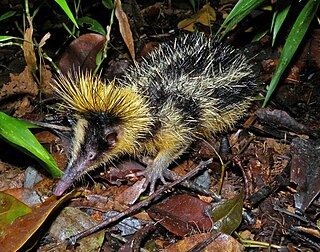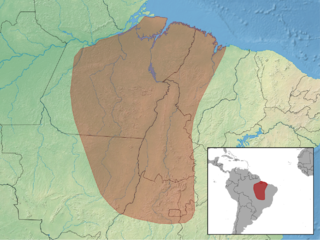
The lowland streaked tenrec is a small tenrec found in Madagascar.
The short-tailed spiny-rat, Proechimys brevicauda, or Huallaga spiny rat, is a spiny rat species from South America. It is found in Bolivia, Brazil, Colombia, Ecuador and Peru.
The Kulina spiny-rat, Proechimys kulinae or Javari spiny rat, is a spiny rat species from South America. It is found in Brazil and Peru.

Roberto's spiny-rat, Proechimys roberti, or Para spiny rat, is a spiny rat species from South America. It is found in Brazil.
Patton's spiny-rat, Proechimys pattoni, is a spiny rat species from South America. It is found in Brazil and Peru.

The Napo spiny rat, Proechimys quadruplicatus, is a spiny rat species from South America. It is found in Brazil, Colombia, Ecuador, Peru and Venezuela.

Simons's spiny rat, Proechimys simonsi, is a spiny rat species from South America. It is found in Bolivia, Brazil, Colombia, Ecuador and Peru. It was named for American scientific collector Perry O. Simons.

Steere's spiny rat, Proechimys steerei, is a spiny rat species from South America. It is found in Bolivia, Brazil and Peru.

Proechimys is a genus of South American spiny rats of the family Echimyidae. All species of the genus are terrestrial. In the lowland Neotropical forests, Proechimys rodents are often the most abundant non-volant mammals. They are recognizable by reason of their elongated heads and long rostra, large and erect ears, narrow and long hind feet, and tails always shorter than head-and-body lengths. The dorsal pelage comprises a mixture of expanded, varyingly stiffened spines — hence the vernacular name of spiny rats — and soft hairs.

Tome's spiny rat, also known as Tomes' spiny rat or the Central American spiny rat, is a species of spiny rat distributed from Honduras to Ecuador. The IUCN has assessed its conservation status as being of "least concern".
The Boyacá spiny rat is a species of rodent in the family Echimyidae. It is endemic to Colombia; it is found primary forest in Carare River valley, Boyacá Department, 100 to 500 meters above sea level. Nocturnal, terrestrial and solitary, it feeds on seeds, fruit and some leaves and insects. It is threatened by habitat loss for mining and agriculture.
The Pacific spiny rat is a species of rodent in the family Echimyidae. It is found in Ecuador and Peru.
The Guaira spiny-rat is a species of rodent in the family Echimyidae. It is endemic to Venezuela. It is commonly referred to as 'casiragua' to avoid confusion with true rats (Muroidea)
O'Connell's spiny-rat is a species of rodent in the family Echimyidae. It is endemic to Colombia.

The Sucre spiny-rat is a species of rodent in the family Echimyidae. It is endemic to Venezuela.
The insular cave rat is an extinct species of spiny rat that was native to Puerto Rico.
Eutrombicula batatas is a species of chigger.

Hemicentetes is a genus of tenrec with two species, present on the island of Madagascar, species in this genus are called streaked tenrecs.
The Antillean cave rat is an extinct species of spiny rat of the genus Heteropsomys that was native to Puerto Rico.

Ribozyviria is a realm of satellite nucleic acids. Established in ICTV TaxoProp 2020.012D, the realm is named after the presence of genomic and antigenomic ribozymes of the Deltavirus type. Additional common features include a rod-like structure, a RNA-binding "delta antigen" encoded in the genome, and animal hosts. Most lineages of this realm are poorly understood, the notable exception being members of the genus Deltavirus, the causal agents of Hepatitis D in humans.








